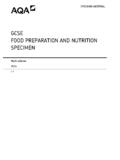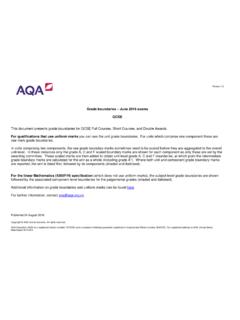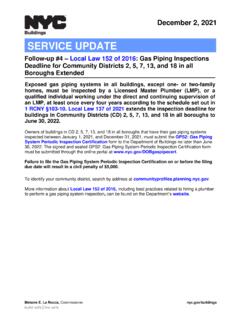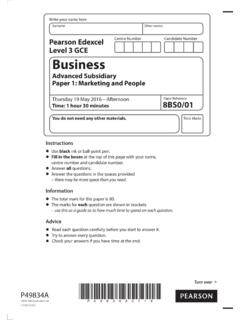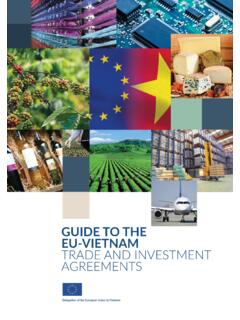Transcription of Question paper (AS) : Paper 1 - June 2016
1 *Jun167401101* IB/M/Jun16/E3 7401/1 AS BIOLOGY Paper 1 Thursday 26 May 2016 Afternoon Time allowed: 1 hour 30 minutes Materials For this Paper you must have: a ruler with millimetre measurements a calculator. Instructions Use black ink or black ball-point pen. Fill in the boxes at the top of this page. Answer all questions. You must answer the questions in the spaces provided. Do not write outside the box around each page or on blank pages. All work must be shown. Do all rough work in this book. Cross through any work you do not want to be marked. Information The marks for questions are shown in brackets. The maximum mark for this Paper is 75. Please write clearly in block capitals. Centre number Candidate number Surname Forename(s) Candidate signature 2 *02* IB/M/Jun16/E3 Do not write outside the box Answer all questions in the spaces provided.
2 0 1 . 1 Table 1 shows features of a bacterium and the human immunodeficiency virus (HIV) particle. Complete Table 1 by putting a tick ( ) where a feature is present. [2 marks] Table 1 Feature Bacterium Human immunodeficiency virus (HIV) particle RNA Cell wall Enzyme molecules Capsid 0 1 . 2 When HIV infects a human cell, the following events occur. A single-stranded length of HIV DNA is made. The human cell then makes a complementary strand to the HIV DNA. The complementary strand is made in the same way as a new complementary strand is made during semi-conservative replication of human DNA. Describe how the complementary strand of HIV DNA is made. [3 marks] 3 *03* Turn over IB/M/Jun16/E3 Do not write outside the box 0 1 . 3 Contrast the structures of DNA and mRNA molecules to give three differences.
3 [3 marks] 1 2 3 Turn over for the next Question 4 *04* IB/M/Jun16/E3 Do not write outside the box 0 2 . 1 Describe the difference between the structure of a triglyceride molecule and the structure of a phospholipid molecule. [1 mark] 0 2 . 2 Describe how you would test for the presence of a lipid in a sample of food. [2 marks] 0 2 . 3 Animal fats contain triglycerides with a high proportion of saturated fatty acids. If people have too much fat in their diet, absorption of the products of fat digestion can increase the risk of obesity. To help people lose weight, fat substitutes can be used to replace triglycerides in food. Describe how a saturated fatty acid is different from an unsaturated fatty acid. [1 mark] 5 *05* Turn over IB/M/Jun16/E3 Do not write outside the box Figure 1 shows the structure of a fat substitute.
4 Figure 1 0 2 . 4 This fat substitute cannot be digested in the gut by lipase. Suggest why. [2 marks] 0 2 . 5 This fat substitute is a lipid. Despite being a lipid, it cannot cross the cell-surface membranes of cells lining the gut. Suggest why it cannot cross cell-surface membranes. [1 mark] 6 *06* IB/M/Jun16/E3 Do not write outside the box 0 3 Cells constantly hydrolyse ATP to provide energy. 0 3 . 1 Describe how ATP is resynthesised in cells. [2 marks] 0 3 . 2 Give two ways in which the hydrolysis of ATP is used in cells. [2 marks] 1 2 0 3 . 3 Figure 2 is a photograph (micrograph) of a mitochondrion taken using a scanning electron microscope. Figure 2 What is the evidence from Figure 2 that a scanning electron microscope was used to take this photograph?
5 [1 mark] 7 *07* Turn over IB/M/Jun16/E3 Do not write outside the box 0 3 . 4 Name the part of the mitochondrion labelled X in Figure 2. [1 mark] 0 3 . 5 The actual length of the mitochondrion between points A and B in Figure 2 is 4 m. What is the magnification of the mitochondrion in Figure 2? Show your working. [2 marks] Magnification Turn over for the next Question 8 *08* IB/M/Jun16/E3 Do not write outside the box 0 4 . 1 The letters P, Q, R, S and T represent ways substances can move across membranes. P diffusion through the phospholipid bilayer Q facilitated diffusion R active transport S co-transport T osmosis For each of the following examples of transport across membranes, select the letter that represents the way in which the substance moves across the membrane.
6 Write the appropriate letter in each box provided. [3 marks] Transport through a channel protein Transport of small, non-polar molecules Transport of glucose with sodium ions Figure 3 shows how a plant cell produces its cell wall. Figure 3 9 *09* Turn over IB/M/Jun16/E3 Do not write outside the box 0 4 . 2 Y is a protein. One function of Y is to transport cellulose molecules across the phospholipid bilayer. Using information from Figure 3, describe the other function of Y. [2 marks] 0 4 . 3 What is the evidence in Figure 3 that the phospholipid bilayer shown is part of the cell-surface membrane? [1 mark] 0 4 . 4 In the cell wall, bonds hold the cellulose molecules together side by side. Tick ( ) one box that describes the type of bond that holds the cellulose molecules together side by side.
7 [1 mark] Ester Hydrogen Ionic Peptide 10 *10* IB/M/Jun16/E3 Do not write outside the box 0 5 Scientists investigated the hydrolysis of sucrose in growing plant cells by an enzyme called SPS. 0 5 . 1 Name the products of the hydrolysis of sucrose. [2 marks] 1 2 0 5 . 2 The scientists grew plant cells in a culture for 12 days. At the start, there were only a few cells in the culture. Each day, they determined the mass of sucrose hydrolysed by SPS in the plant cells in 1 hour. Table 2 shows their results. Table 2 Day Mass of sucrose hydrolysed by SPS in 1 hour / g Rate of hydrolysis of sucrose by SPS 0 2 4 6 8 10 12 For each day, calculate the rate per minute of the reaction catalysed by SPS. Record the rates in standard form and plot a suitable graph of your processed data.
8 [3 marks] 11 *11* Turn over IB/M/Jun16/E3 Do not write outside the box 0 5 . 3 What can you conclude about the growth of the plant cells from these data? Explain how you reached your conclusions. [3 marks] 12 *12* IB/M/Jun16/E3 Do not write outside the box 0 6 . 1 Describe the induced-fit model of enzyme action. [2 marks] 0 6 . 2 A scientist investigated the hydrolysis of starch. He added amylase to a suspension of starch and measured the concentration of maltose in the reaction mixture at regular intervals. His results are shown in Figure 4. Figure 4 Determine the rate of the reaction at 10 minutes. Show how you obtained your answer. [2 marks] Rate of reaction mg dm 3 min 1 13 *13* Turn over IB/M/Jun16/E3 Do not write outside the box 0 6.
9 3 Explain the results shown in Figure 4. [2 marks] 0 6 . 4 A quantitative Benedict s test produces a colour whose intensity depends on the concentration of reducing sugar in a solution. A colorimeter can be used to measure the intensity of this colour. The scientist used quantitative Benedict s tests to produce a calibration curve of colorimeter reading against concentration of maltose. Describe how the scientist would have produced the calibration curve and used it to obtain the results in Figure 4. Do not include details of how to perform a Benedict s test in your answer. [3 marks] 14 *14* IB/M/Jun16/E3 Do not write outside the box 0 7 . 1 Human papilloma virus (HPV) is the main cause of cervical cancer. A vaccine has been developed to protect girls and women from HPV.
10 Describe how giving this vaccine leads to production of antibody against HPV. [4 marks] 15 *15* Turn over IB/M/Jun16/E3 Do not write outside the box 0 7 . 2 Doctors investigated whether it was better to give two or three doses of the HPV vaccine. They determined the mean concentration of antibody against HPV in blood samples from girls who were given either two or three doses of the vaccine. Girls given two doses received an initial vaccination, followed by a second at 6 months. Girls given three doses received an initial vaccination, followed by a second at 1 month and a third at 6 months. The doctors measured the concentration of antibody each month. The results are shown in Figure 5. Figure 5 What do these results suggest about whether it is better to give two or three doses of the vaccine?









